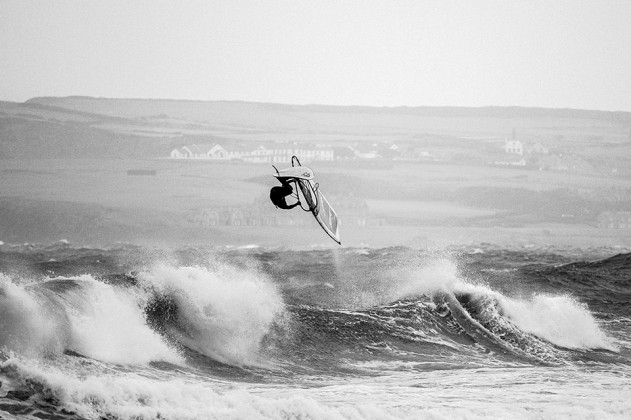FINN MULLEN COOL WINDS EDITORIAL
Words Finn Mullen // Photo Tam Mullen
(This feature originally appeared in the November December 2015 issue of Windsurf Magazine. To read more features like this first, Print and Digital subscriptions are available. Prices include delivery globally for 10 x issues a year!)
“ Whenever I find myself growing grim about the mouth; whenever it is a damp, drizzly November in my soul – then, I account it high time to get to sea as soon as I can ” Herman Melville, Moby Dick.
Winter is taking its breaths; breezes blow harder, maturing to the gales we love but respect even more. We are a tribe of the water; as the seasons change our senses perceive, adapt and rejoice at the feast of increased knots and gusts to come. It’s a feast that others do not seek an invite to. Indoors is not our place in winter, behind the mast is! We yearn for winter’s call, the challenge of the strongest of seasons to sail in. Of course all this assumes that we have a normal, windy winter; when in fact everything about our weather so far this year has been anything but normal!
Scientists have a term, ‘indicator species’; that is a species that can signal a change in the condition of a particular ecosystem. Our sport being so closely driven by the weather and our stadium being water made, we are a good indicator species for changes in the environment. No UK sailor could have failed to notice this summer’s abundance of wind and lack of heat, but speaking to a windsurfing friend from Maui, he reported their summer was quite the opposite. Normally famed for its strong and cooling trade winds, Maui’s summer was beset by periods of no wind and the hottest August ever recorded.
Much has been made in the media of 2015 being an ‘El Nino’ year. El Nino being the pattern of above average Pacific sea temperatures understood to influence much of the planet’s climate. America’s National Oceanic and Atmospheric Administration recently confirmed that the first eight months of 2015 were the hottest yet recorded for the globe’s surface land and oceans, based on temperature records going back to 1880! Warming of the Pacific has been observed and reasoned by more than just the effects of El Nino but may explain the weakening of Hawaii’s trade winds and summer sweating. Less widely reported and more concerning for UK sailors is a cooling in some areas closer to our home waters. “The North Atlantic between Newfoundland and Ireland is practically the only region of the world that has defied global warming and even cooled.” said German Oceanographer Stefan Rahmstorf in a recent report. Stefan and some fellow scientists propose that the cooling is part of a process that has been long feared by climate researchers – the slowing of Atlantic Ocean circulation. They hypothesize that the massive Greenland ice sheet may now be losing enough freshwater due to melting to weaken the circulation. This circulation is important because it brings warm water northward, thereby helping to warm the UK’s climate.
“ Indoors is not our place in winter, behind the mast is! ”
There is a school of thought that warming temperatures heat up the surface of the oceans, increasing evaporation and putting more water vapour into the atmosphere. This in turn provides added fuel for storms as they travel over open oceans. So El Nino could provide much larger surf than normal in the Pacific while a cooling Atlantic could offer a depressed hurricane season? As with any discussion about climate change and weather, there are more answers than questions and the answers can be worryingly diverse. Others in the scientific community argue that temperature changes are cyclical or part of a natural variation. When we discuss on the beach how our 3.2 was so well used in the last significant El Nino winter of 1997 that it resembled a well worn crisp packet trampled by untrained dancing elephants and that kids today don’t know how unlucky they are to be born in such windless doldrums of times, we are of course talking complete climatic rubbish, worthy of Volkswagen’s emission testing PR department. Ben Freeston, founder and forecaster at popular surf forecast website Magicseaweed.com, wrote recently on the ignorance of making such observations – ‘’What’s fascinating is the relative insignificance of our data in understanding these phenomena. Surfers are often given to speaking of a swell or run of weather as unusual, even exceptional, but in climate terms our recollections are a blink of the eye. Even with 40 to 50 years of detailed data we’re seeing no more than hints of patterns – that’s nearly a lifetime’s surfing for many of us. While El Niño itself is a cyclical phenomena its development is impacted by other climate cycles, many of which can operate on multi-decadal or longer time frames.’’
Whatever the reason, we know that we lie on the cusp of a winter that is expected to be of notable change and as an indicator species there is only one natural reaction we can reasonably be expected to scientifically perform – go windsurfing!
PHOTO CREDIT Winter is coming and no one is quite sure what it will bring this year. Finn Mullen observes the cool Atlantic from above, deep in the heart of Game of Thrones country at Whiterocks beach, Northern Ireland.


